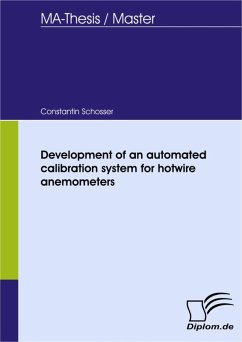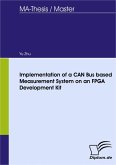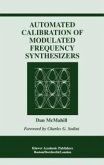Inhaltsangabe:Introduction: In experimental fluid dynamic measurements hot-wire anemometry is used to record information about flow fields. Furthermore one can obtain the magnitude, the direction and even the time dependant behaviour of the fluid flow, if multiple-wire probes are in operation. The hot-wire measurement technique is based on the convective heat transfer from a heated element to the fluid flow, which is actually proportional to the velocity of the flow. So HWA is an indirect measurement technique. There are miscellaneous sensors which work properly in water or other liquids, air or in gas flows. As an example, Fig. 1.1 shows a cross-wire probe in a fluid flow, which can detect the velocity and its direction in two components, if the main flow direction is in one plane (2D flow). Predominantly HWA is a research tool for turbulent flow studies, especially transient procedures. Turbulence models have to be built to represent the characteristics of the flow in numerical simulations (CFD). Therefore only detailed experimental measurements lead to reliable information about the local velocity of a turbulent flow. This can be provided by HWA on the basis of its very high spatial and temporal resolution. Although the development of HWA started at the beginning of the 19th century and new techniques like PIV or LDA (direct methods) have been established, it is still a common device in all wind tunnel labs. The analogue output signal can be optimized by filters before signal processing. It can also be deployed to arrange a spectrum analysis, due to the high temporal resolution. Moreover, unlike the digital devices the analogue signal is densely packed. The range of application is large and leads from sub- and supersonic flows, the independency of the medium to high-temperature measurements. HWA is also affordable in contrast to LDA and PIV systems. In spite of these advantages the natural contamination of the hot-wire probe increases by and by, since the particles in the fluid flow mature themselves to the probe and finally isolate it. As this effect of disturbance causes measuring errors, the hot-wire probes have to be calibrated at frequent intervals - best before and after every data acquisition series. However, HWA is an intrusive measurement technique, thus disturbing the flow. Another disadvantage is that it is not applicable in separation and backward flow regions. The aim of this thesis is to develop an automated calibration system to [...]
Dieser Download kann aus rechtlichen Gründen nur mit Rechnungsadresse in A, B, BG, CY, CZ, D, DK, EW, E, FIN, F, GR, HR, H, IRL, I, LT, L, LR, M, NL, PL, P, R, S, SLO, SK ausgeliefert werden.









